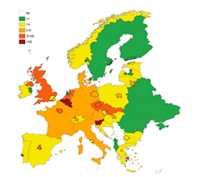Advertisement
Grab your lab coat. Let's get started
Welcome!
Welcome!
Create an account below to get 6 C&EN articles per month, receive newsletters and more - all free.
It seems this is your first time logging in online. Please enter the following information to continue.
As an ACS member you automatically get access to this site. All we need is few more details to create your reading experience.
Not you? Sign in with a different account.
Not you? Sign in with a different account.
ERROR 1
ERROR 1
ERROR 2
ERROR 2
ERROR 2
ERROR 2
ERROR 2
Password and Confirm password must match.
If you have an ACS member number, please enter it here so we can link this account to your membership. (optional)
ERROR 2
ACS values your privacy. By submitting your information, you are gaining access to C&EN and subscribing to our weekly newsletter. We use the information you provide to make your reading experience better, and we will never sell your data to third party members.
Chemical Regulation
Number of chemicals in commerce has been vastly underestimated
Scientists assemble a first-ever global inventory listing triple the number of chemicals on the market as previous lists
by Janet Pelley, special to C&EN
February 12, 2020
| A version of this story appeared in
Volume 98, Issue 7

For the first time, scientists have created a global inventory that lists more than 350,000 chemicals and mixtures of chemicals registered for commercial production and use, up to three times as many as is commonly estimated (Environ. Sci. Technol. 2020, DOI: 10.1021/acs.est.9b06379).
By the numbers
157,000: Individual listed on chemicals identified by CAS numbers, according to the most comprehensive global inventory to date. a
75,000: Mixtures, polymers, and substances of unknown or variable composition. a
120,000: Substances that could not be conclusively identified
Source: Environ. Sci. Technol. 2020, DOI: 10.1021/acs.est.9b06379. a Individual chemicals, mixtures, polymers, and other substances were identified by CAS numbers.
This inventory can help researchers track compounds that are expected to be volatile, persistent, or capable of long-range transport, which is important for building a picture of global chemical safety, says Cynthia de Wit, an analytical chemist at Stockholm University. “Because we live in a global economy, we really require a global framework,” says de Wit, who was not involved in creating the database.
Previous research studies to grasp the effects of certain chemicals on ecosystems and human health have relied mainly on inventories from the US, Canada, and western Europe that total around 100,000 substances. “While these countries dominated chemical production in the early 2000s, their market share has declined, and now China, India, Brazil, Russia, and South Africa account for 40% of chemicals in trade,” says Zhanyun Wang, an environmental scientist at ETH Zurich. So he and his colleagues decided to do better, compiling all the chemical inventories they could find around the globe.
The scientists downloaded and combined publicly available inventories, expanding from North America and Europe to include 16 other countries and regions encompassing all the top 10 chemical producers except Brazil and Saudi Arabia. The combined list includes 157,000 individual chemicals identified by their Chemical Abstracts Service (CAS) number, a unique number assigned to only one substance. It also includes 75,000 mixtures, polymers, and “chemical substances of unknown or variable composition” also identified by CAS numbers.
Another 120,000 substances could not be conclusively identified. Roughly 70,000 of these were too poorly described to link to a CAS number. The identities of the remaining 50,000 substances were shielded as confidential business information.
The researchers plan to make the full database public, but they need to raise money to hire someone to create a user-friendly interface, Wang says.
Analysis of the global inventory reveals that about one-quarter of the CAS-numbered chemicals are not included in the North American and European inventories commonly used to evaluate chemical exposure and impact. This finding shows that countries are making, using, or importing some 60,000 chemicals “that are not well understood and regulated,” Wang says.
In addition, almost every country has significant numbers of chemicals that are registered only in that country. For example, nearly one-fifth of Taiwan’s inventoried substances are listed nowhere else.
This study “flags that researchers and governments need to work together with more resources to responsibly manage chemicals,” Wang says. He hopes that a UN-sponsored effort to manage chemicals will lead this year to a framework that includes a global inventory.





Join the conversation
Contact the reporter
Submit a Letter to the Editor for publication
Engage with us on Twitter